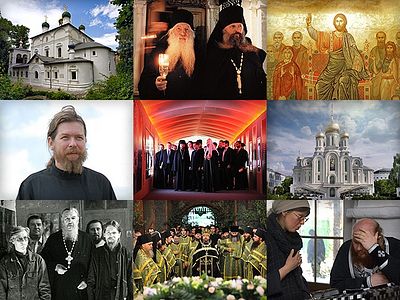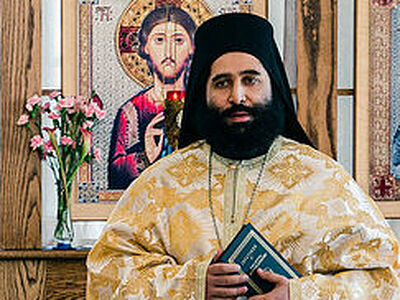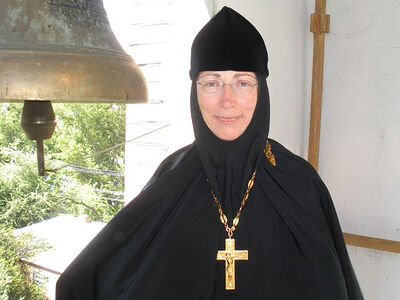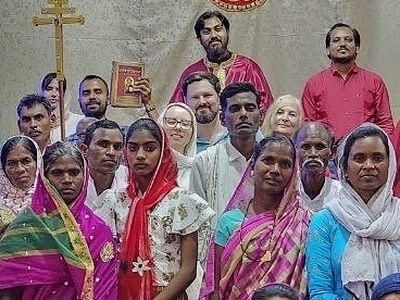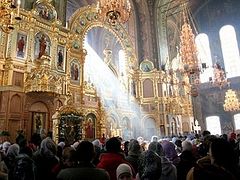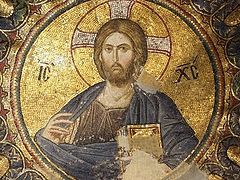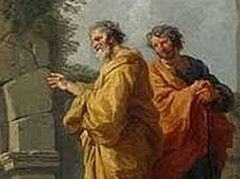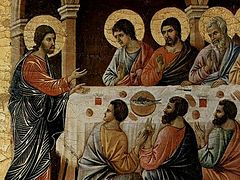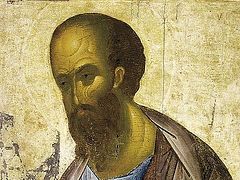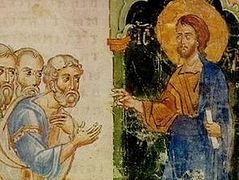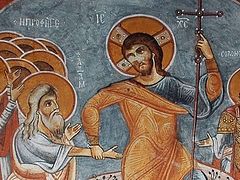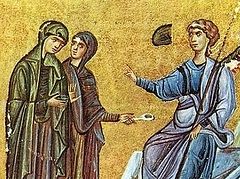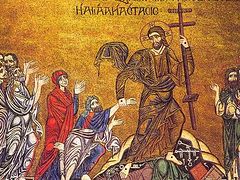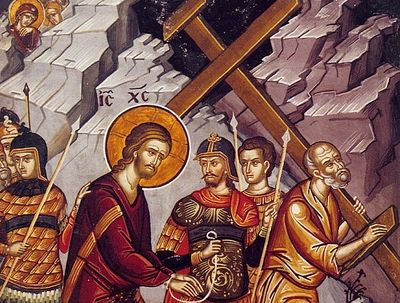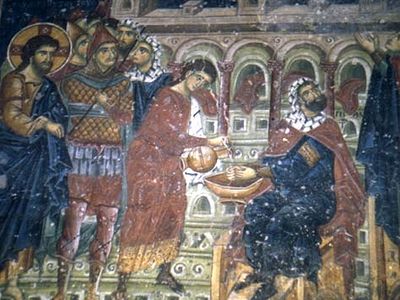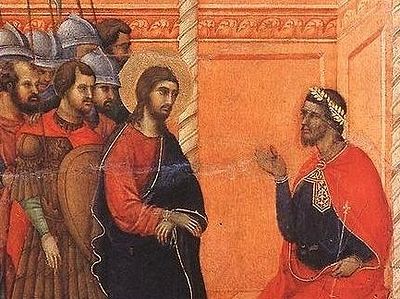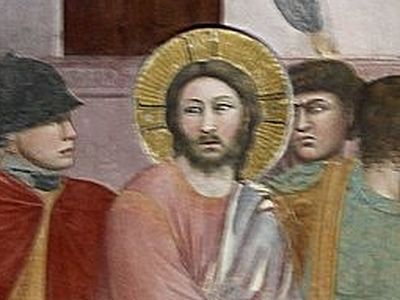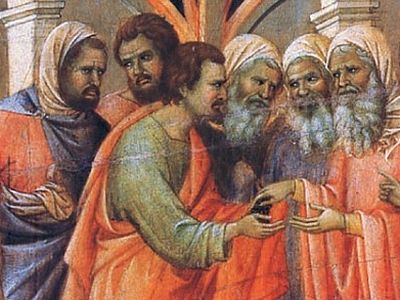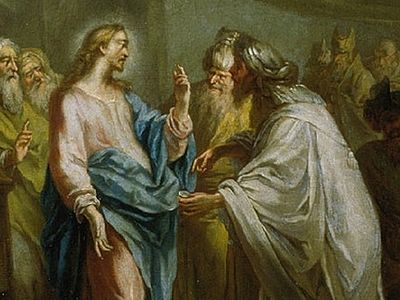See On the Resurrection of Christ, Part 1
Dr. Jeannie Constantinou discusses the various doubts that periodically come up about Christ’s burial, about witnessing to Christianity by the example of our lives, and about the consistency of the Gospel histories on the Resurrection.
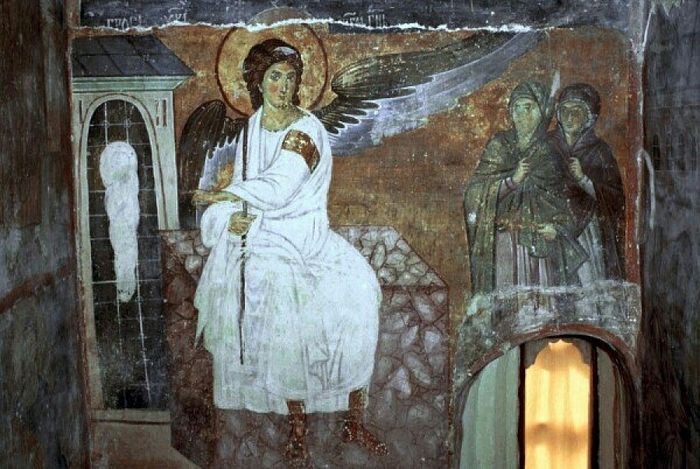 White Angel. Mileševa monastery
White Angel. Mileševa monastery Christos Anesti! Christ is risen!
Christ is Risen from the dead, trampling down death by death, and upon those in the tombs bestowing life. Amen.
In our last lesson on the Resurrection we discussed the importance of belief in the Resurrection, whether there is any evidence of the Resurrection, and why God does not give us proofs of the Resurrection or of His existence. We discussed some of the arguments raised by people against the Resurrection, the significance of some details that we find in the Gospel accounts such as the empty tomb and the burial cloths. Today, let’s discuss some other details we find in the Gospel accounts of the Resurrection, including the angelic appearances, the Lord’s appearances to various people, the meaning of the “three days in the tomb” language etc.
A listener wrote to ask me whether I had ever heard of an argument raised against the Resurrection in an article that was posted on a particular website, which said that, basically, the women found the empty tomb because Jesus was never buried there, or that His body was removed from the tomb before the women arrived because the bodies of crucified criminals were not buried. I wasn’t going to go back and re-discuss that, and I tried to respond, but the email was bounced back to me so I thought perhaps I will address this since we’re still on the Resurrection.
First let me note that I had said that in most parts of the Roman Empire the bodies of the crucified criminals remained on the crosses until they rotted away and there was nothing left except a skeleton. This was part of what made the Roman practice of crucifixion in the Empire so horrific. They generally did not bury the bodies—that’s correct. But there are many things that happened in Judea that were an exception, because of Jewish law, and the Romans did not want to upset the Jews so they would observe certain Jewish practices. This did not happen to Christ. Christ would have been buried, so the idea that He never would’ve been buried is certainly not true, because He died in Judea, and Jewish law would not permit someone to remain unburied, even a convicted criminal. So He definitely was buried.
This article also said that Christ, as a convicted criminal, would not have been buried in a tomb because this would not have been permitted. I don’t know about that, I have never seen any historical discussion to that effect—that He never would have been buried because He was a criminal. And even if that was customary, because the death of criminals would have been defiling—that’s possible—we have two prominent Jewish leaders, Joseph of Arimathea and Nicodemus, who were the ones who saw to the burial of Christ. Very often people in positions of power and influence can make things happen that ordinarily would not have happened. But I think that even if had He been considered a criminal, one of the reasons why He may have been buried in a tomb was because it was a new tomb. It was not a family tomb yet. It had never been used, so there probably would not have been any objection to it on the part of anyone. And I’m also certain that the Jewish leaders would not have objected to Christ being buried in someone’s tomb. They just wanted Him dead. So there’s no reason for them to object to Him being buried in a tomb. And the tomb is being provided, it’s new, nobody has used it, and nobody used it after that, either. One other factor to remember is the fact that most people considered Christ a prophet, not a criminal. So I strongly doubt that He would have been denied a proper burial.
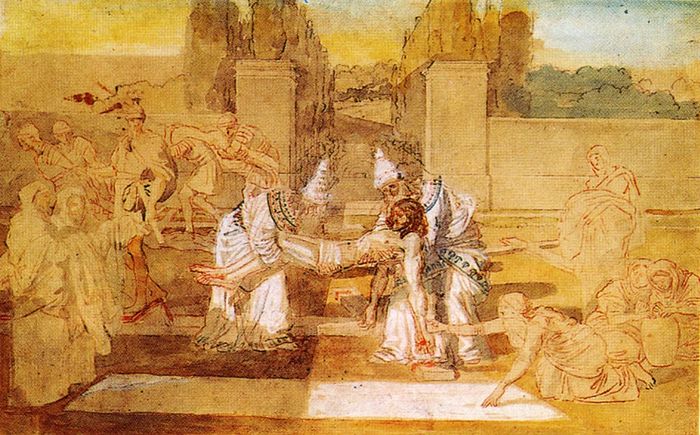 Joseph of Arimathea and Nikodemos transfer the body of Christ (Ivanov A. A., 1850s)
Joseph of Arimathea and Nikodemos transfer the body of Christ (Ivanov A. A., 1850s) Another possibility raised by this article is that Christ was removed from the tomb and put into a common grave for criminals. The women see Him, Joseph and Nicodemus help to entomb Christ, they put Him in the tomb, and they close it with the stone. And then later someone comes and takes Him out and says, “No, no this isn’t possible. This isn’t right! He shouldn’t be in this tomb!” and they take Him and bury Him in a common grave for criminals. Now just considering this from a logical perspective, who would have done that? The Romans? Would the Romans have done that? Of course not—they don’t care. They wouldn’t care where Christ was buried. They’re not going to take the time and trouble to move Him to some other tomb or some grave they think is appropriate. Who would’ve done it? The Jews? Well, the Sabbath had arrived. The Jewish leaders would not have been running around unburying Christ, putting Him in some other grave. And they wouldn’t care either. He’s dead, that’s all they cared about. Even so, if they had done that (because they would be the only people who would think it was improper for Him to be in a tomb), then why do they go and ask Pilate for guards, and a seal to secure the tomb? You see, we have to consider all of the evidence. Why didn’t they say, after the Resurrection, that they had moved the body, and that explains the empty tomb; that somehow it was inappropriate for Him to be placed in a tomb and so they put Him in a proper grave. They don’t say that. Instead they say that the disciples stole the body. So you see there’s a whole long article devoted to all these possibilities and every single thing it raises has absolutely no historical evidence to suggest it. There is no historical evidence, there is not one story, not one shred of evidence that suggests that He was never buried or that He was removed and put in a grave in the ground that was basically for common criminals, a common grave. You see there’s nothing to suggest this, and yet they write a whole big article with these kinds of possibilities. What we have is historical documentation, brothers and sisters. We have to remember that the Bible is not only Scripture. It is a historical document, and this counts for something, whereas what they have is nothing. They have just speculation, and no historical evidence whatsoever.
This is, of course, an argument against the empty tomb, or some reason for the tomb being found empty, some reasons proposed by people who don’t believe in the Resurrection. Now the empty tomb is one factor pointing to the Resurrection, but it is not the only factor. We also have the appearances and the burial cloths left behind. And there again, I cannot explain why anyone would leave the cloths behind or how it would even be possible to leave them behind. Chrysostom mentions this also. He was more familiar with burial practices. He knew that once you put myrrh and aloes on the cloths and the body, that, after a rather short period of time, the resin dries. The substances dry and they become very stiff and almost impossible to remove from the body. So, there again, when we have the burial cloths, why would they be left behind by someone who unentombs Christ and goes and takes Him someplace else? That doesn’t make sense either.
In addition to the empty tomb and the burial cloth left behind, we also have the Resurrection appearances by Christ. Let’s say for the sake of argumentation that the Lord was not in that tomb. Let’s say that they removed Him and placed Him in a common grave for criminals. You still have to explain the Resurrection appearances. You still have to explain the existence of the Church; and this is, frankly, the strongest evidence for the Resurrection that exists, if you ask me.
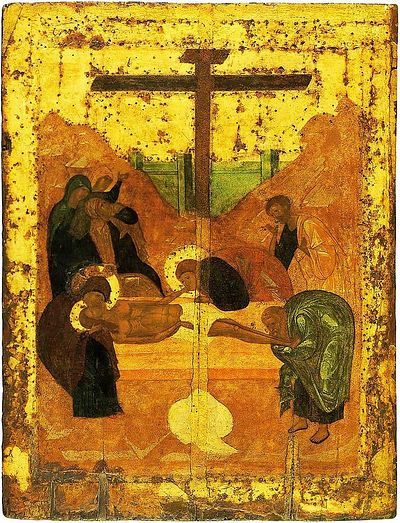 "The Placing in the Tomb," icon studio of A. Rublev (near the tomb is seen the folded shroud)
"The Placing in the Tomb," icon studio of A. Rublev (near the tomb is seen the folded shroud) This particular article on this website also said that the disciples did not begin to preach about the Resurrection right away, but they kept it a secret until Pentecost, and then they began to preach about the Resurrection after Christ’s body had already decomposed and He was unrecognizable. First of all, there’s nothing to suggest that they were trying to “keep it a secret.” Everyone’s running back and forth telling each other, “We have seen the Lord!” Do you think that this was kept secret? Of course this was not kept secret! There were many, many people who knew about the Resurrection right away, on day one—so this was not a secret. It is true that they did not begin preaching about the Resurrection until Pentecost, but that’s because the Lord told them to wait. Pentecost is the beginning of the Church. That’s when they receive the Holy Spirit. They begin to preach about the Crucified and Risen Lord, but it wasn’t a secret before that. And you still have the question of why these people would preach a complete lie. Why would they spend their lives promoting a lie? Because after Pentecost, is when they begin to be arrested. They begin to be persecuted by the Jewish leaders. They’re arrested, put into prison, taken before the Sanhedrin, Stephan is stoned to death… So we don’t have them just deciding all of a sudden they’re going to start preaching the Resurrection and everything is great and they have something to gain. They have nothing to gain by spending their lives promoting the message that Christ rose if He didn’t.
This kind of argument is, again, entirely speculative—there is not one shred of evidence that the Resurrection was kept secret and they were formulating this plot to deceive the world by saying that He rose when in fact He didn’t. This kind of an article, this kind of argumentation, at its heart reflects really the arrogance of our times: that only we are intelligent, that only we are honest and that people long ago had nothing to live for. They didn’t value their lives. They didn’t love their children and their homeland. They had nothing to lose by promoting a complete fabrication. Do you see how this doesn’t make sense? The disciples loved their children, they loved their families, they loved their relatives, they loved their lives, they loved their fishing and yet they gave that up to live the life an Apostle, which was a very difficult life, dear brothers and sisters.
I already explained this at great length, so I’m not going to go there again. You can listen to the earlier podcast if you haven’t heard what I said about the lives of the Apostles. But anyhow, I do not spend time on websites reading or responding to arguments against Christianity, against the Resurrection, against Orthodoxy. I don’t have the time and I don’t have the patience for that, and the main reason why I don’t do that is because I do not think that people are generally convinced by arguments. They have their opinions and they usually stick to them, and this goes back to the same point I was discussing in the previous podcast. Nothing will convince people who wish to disbelieve. And this was what St. Paul was saying when he was talking about the Crucifixion. The Crucifixion and the Resurrection basically are unbelievable, and if people are determined to disbelieve, no amount of convincing will convince them. Something else may convince them. And I want to just mention that to you.
A couple of weeks ago I went to Toronto to speak about the Trials and the Crucifixion of Christ at an Orthodox Church there, and met a man who came up to me to discuss something that bothers him. He told me that he frequents a Greek coffee house at which there are Greeks who believe in and worship the ancient Greek gods, and I started laughing because I had heard about this, but I didn’t really believe it was true. He said, “No, they’re serious.” They believe in the ancient gods, and it’s amazing to me that anyone still would worship the Olympian gods, but he told me that they’re serious about this. I had heard that there are some people like this in Greece (they are a very small group of people, they’re kind of a kooky element, you’ve got kooks everywhere). So now in Greece you have a small group of people who insist on worshiping the ancient gods, because, of course, that’s when Greece was its most glorious. That’s when it was the Golden Age of Greece, when they were worshiping the gods, so they promote this kind of thing. Now what this Orthodox Christian asked was how he could convince them they were wrong. I told him, “You can’t. You can’t convince them.” And he said, “Well then, what can I do?” And I said simply, “Behave like a Christian. Show them by example.” And, dear brothers and sisters, that’s all we can do. We can never convince people by proofs or arguments, science or history or anything else, because in fact that’s not what the first Christians did either. That’s exactly what St. Paul was saying in 1 Corinthians. Look in chapter 1 and 2. He said, “We preach Christ crucified.” “I did not come to you with words of eloquence. I came to you with an unbelievable concept: a crucified Messiah.” So we cannot convince people. So the early Christians simply preached the message, and whoever believed, believed. And they faced great persecution.
So how can you explain the existence of the Church? Why did Christianity continue to grow in spite of persecution? Was it because they came up with some better arguments, they came up with some convincing proofs? Did they come up with some rhetorical, convincing, persuasive words? Did they come up with historical verification? They had no video, right? No scientific proof, just as we don’t now. What convinced people? There were two things, and I’m telling you the two things you will see in all of the early historical documents of Christianity. We have quite a few writings, not as many as we would like to have, but we do have many writings from the first two and three centuries of Christianity, during the time of persecution. What attracted people to Christianity in spite of “the foolishness of what we preach,” as St. Paul called it? What attracted people? Two things: first, the lives of the Christians, their deeds, the fact that they loved their enemies, the fact that they saw the Christians burying people who had no one to bury them, that they cared for strangers, for orphans, for the poor, for widows. This impressed the Greeks, because this is what Greek philosophy advocated: virtue. And they saw this and were impressed by it. Many people were attracted to Christianity by the virtue shown by these first Christians.
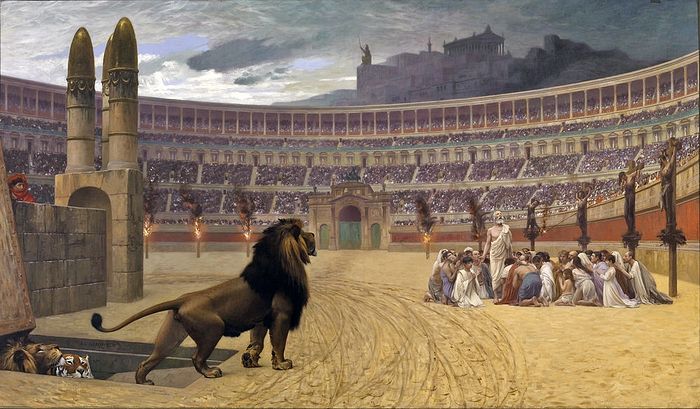 Jean-Léon Gérôme. The Christian Martyrs' Last Prayer. Photo: Wikipedia
Jean-Léon Gérôme. The Christian Martyrs' Last Prayer. Photo: Wikipedia And the second factor was the fact that when they saw these Christians being persecuted—very often in the arena facing wild animals and gladiators and all kinds of torture—they saw the Christians going to their deaths bravely and cheerfully. And this amazed the Romans. It absolutely amazed them to see these people, and sometimes they were women, sometimes they were children going to their deaths with great bravery and with cheerfulness. And this really caused them to think: what is it about these people? What do they have? So, it was not convincing proofs, or any type of proof, that led people to Christianity. It was the life of the Christians. And this is what we need, dear brothers and sisters, not words, to convince people of the truth of our message. And the fact is, according to the Fathers—and reading Chrysostom, you’ll see this all of the time—if people don’t believe in Christianity it’s our fault—not because we haven’t come up with better proof, but because we’re not living the lives that we have been called to live as Christians. And Chrysostom says that we are answerable to God for the fact that others do not believe. When we do not live the life, we will be judged for that. This is something very sobering that we need to be thinking about. So people who wear their crosses everywhere, sometimes like jewelry—I don’t know what they’re doing wearing crosses. Sometimes you see this now and it’s very chic; you see rock stars wearing crosses, and the lives that they live are complete debauchery, yet we see them wearing crosses. It’s obscene to me. We have rap stars wearing big gold crosses but what they’re promoting in their music is immorality. They get awards for this and then thank the Lord Jesus Christ for their awards—as if He has something to do with the immorality in their videos. And then people look at this and say, “This is a Christian?” But in the early Church, the first Christians led lives of great virtue, and this attracted people to the Church despite the message. Or they might have said, “Maybe there is something to this crucified Messiah concept, because look at the way these people live their lives.” It was very admirable, and we have lost that. So what we need, dear brothers and sisters, are not better words but better deeds. That’s enough sermonizing for today. I did not intend to sermonize the way I did last time.
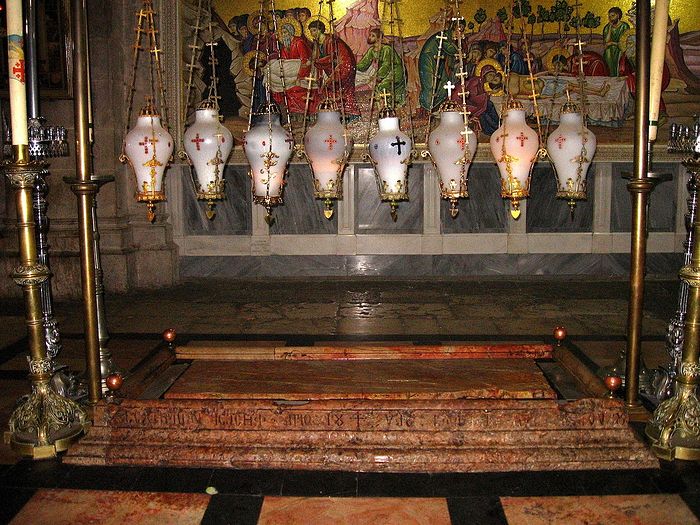 The Stone of Anointing
The Stone of Anointing Anyhow, let’s talk about the “three days in the tomb” language, because I have been asked about this. So, why does it say that the Lord was in the tomb for three days? He predicted that He would rise after three days. That’s Christ’s prediction. If you look at John chapter 2, after He cleanses the Temple and they ask Him, “By what authority do you do this?” He says, “Destroy this Temple (referring to His body), and in three days I will raise it up.” So we have this language, we have the “sign of Jonah” statements by Christ, using the Jonah typology, that Jonah was in the whale for three days and he came out. So it was Christ who gave the Church the “three day” language; it’s not us, but Him. Because He used that terminology, we use it. But how do you get the calculation of “three days”? Was Christ wrong when He said He was in there for three days? Well, when we use this kind of language we think of three 24-hour periods, but that’s not the way the Jews counted their days.
Before I explain how they counted their days, let’s talk about the expression “after three days.” The fact is that “after three days” was an Old Testament expression of deliverance, and we see this in the book of Hosea, and also in Jewish Midrash. Midrash is a kind of Jewish commentary on the Old Testament, and the Midrash on one of the passages in Genesis says, “The Holy One never leaves the righteous in distress for more than three days.” So this was a typical Jewish expression of deliverance or salvation.
What about the fact that the Lord was not in the tomb for three full days? The way we would count would be closer to three 24-hour periods, and this of course did not happen. Well, the reason why, according to the Jews, He was in the tomb for three days, has to do with the Jewish mode of counting the days. First of all, it counts the first and last days in the period, whether or not it’s a whole day or just a partial day—so follow me on this now. And, of course, you also know that the Jewish day began at sunset, not at sunrise or not at midnight. We know this very well from the Church, because we have very often evening Divine Liturgies. How is that we can have an evening Divine Liturgy before the actual day? For example, if it’s the feast day of the Annunciation, which is on March 25, how is it that we’re permitted to have an evening Divine Liturgy and celebrate the feast of the Annunciation on March 24? That’s not the right day. But if it’s during the evening, the night before, we can do this, because the day begins at sunset. That’s the Church rule also, and we get that from the Jews. So the Jewish day begins at sunset. You know this also because Sabbath begins Friday at sunset. That’s not something special for Sabbath; that’s something that’s just the way they understood the day: it begins with the sun going down, not with the sun going up. It’s a different way of thinking. Christ dies on Friday. It’s still daytime, right? He’s in the tomb on Friday—that’s day 1. When sunset arrives, that’s technically Saturday, day 2, the Sabbath. Then He’s still in the tomb a whole day on Saturday when sunset comes back again, and that’s day three, that’s technically Sunday, the next day, the first day of the week. So He’s in the tomb for three days according to that understanding, and that’s the most ancient understanding. That’s why we still use it in the Church, because that was the way the Jews counted it. So even though He wasn’t in the tomb for 24 hours, they would’ve said He was in the tomb for three days because He was there for Friday, on Saturday and also Sunday which began on what we would call sunset on Saturday. So that’s pretty easy to explain.
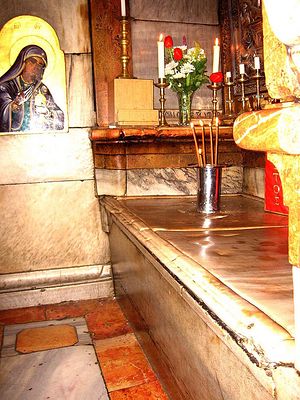 The Holy Sepulchre
The Holy Sepulchre People like to attack the Gospels as inaccurate or unreliable because we find different details in the Gospels. But I really don’t think that that’s a very strong argument, even though we have the Resurrection stories told, as I’ve said, slightly differently. But really what we have are different stories told by different Evangelists similar to what we have in the case of the Crucifixion. So, there are certain commonalities and yet there are differences in the way it’s told, and they don’t include all of them. No Evangelist has all of the stories.
Now, because of the varieties of the accounts, over the years it was very common among people, including among the Fathers, and even to the present day, to engage in what’s called “harmonization” of the Gospels. To “harmonize” the Gospels means to make a lot of effort to show that in fact the Gospels don’t disagree with each other in any detail, but they are in full agreement, they are harmonious. This is called “harmonization.” I don’t engage in harmonization, I don’t think it’s necessary. The first people to attack the Gospels as inaccurate and untrustworthy were Jews and pagans, and this was happening during the time when Christianity was illegal. And of course the early Christians did engage in harmonization because they were trying to defend the Gospels, and these efforts to defend the Gospels against attacks have been going on for a very long time. But I think we have reached the point where we can understand that I don’t think we have to defend the Gospels. I personally don’t think so. We should respond to what people say, but I don’t think it’s necessary to engage in harmonization to explain such things.
First of all, what I have noticed is that most of the differences in these details have to do with the experiences of the women experiencing the Risen Christ. In fact, this makes sense, if you ask me, because women didn’t write the Gospels. And the women’s experiences were really not taken into account quite as seriously as the men’s experiences, because, of course, the testimony of women didn’t count, as I’ve mentioned this many times. So, I think that that’s when most of the variations occur: what happens to the women, the women go to the empty tomb, they see Christ, they see the angels. The biggest degree of variation happens in that context and I think it’s because the men didn’t bother to try to remember the testimony of the women because it didn’t count. That’s just my theory, but I think it’s very possible. I don’t think it’s important. Chrysostom would call these differences “insignificant,” “ta mikra”. That means “little things”. You know that the word “micro” means small? “Ta mikra” are the “small things”, insignificant details. One of the translations that I’ve seen in the post-Nicene Fathers series of Chrysostom that they translate the word “ta mikra” as “trifles.” I think that’s a good word—these are trifling details. Was there one angel or were there two? Was the stone already rolled away or was it rolled away in their presence? Did He appear to the myrrhbearers as a group, but also to Mary Magdalene separately, or was she part of this? Does it really matter? Chrysostom would say, “No. These things don’t matter. These are “mikra,” small things, insignificant details.” And he’s right, these things are minor details.
Chrysostom and the other Fathers would also typically say that differences among the Gospel accounts or the lack of perfect agreement in all details of the Gospels shows the truthfulness of the Evangelists, and that they wrote independently of each other. I think this is a very good point. Sometimes they say that this is just a way for them to excuse the differences among the Evangelists, but if really you think about this, it is actually a very important argument. The fact is that the Evangelists were not sitting down together at the same time and the same place writing their Gospels. They wrote independently; and in fact, consider that they wrote at different times and in different places, actually quite a time removed. They didn’t sit down and write these Gospels the day after it happened. They wrote decades after it happened, maybe 20 years at the minimum, and more like 30 years or 40 years after these things happened. They did not get together to “get their stories straight.” The fact that we see minor variation shows the truthfulness of the Evangelists, because it shows that they did not fabricate these things in order to deceive people. When people want to fabricate a story, like when criminals come up with an alibi, they get together and try to smooth out the details of the story so they will be believable. When they’re creating false testimony, this is what people do. “Let’s get our facts straight so we don’t disagree.” Actually, these minor differences among the Evangelists shows there was no collusion, no fraud. It shows a greater reliability, greater trustworthiness and veracity by the Evangelists, not less.
The truth is that among the Gospels we really have a rather remarkable degree of agreement. We don’t have one Evangelist telling about the empty tomb and no appearance to the women, then another Evangelist just talks about the appearance to the women, another Evangelist just talks about Christ’s appearance. We have a lot of commonalities among the accounts. It’s the little details that differ; and frankly that doesn’t matter. If you think about it, it’s remarkable that the Gospels have been left alone, that they have been allowed to stand untouched. The Gospel editors related everything the way they heard it or the way they remembered it, even though the Church knew from the beginning that these four accounts did not agree in every detail. Do you think someone could have tried to fix it, to change the Gospel accounts so that they all match? It would have been difficult to do but there could’ve been efforts to do that; however, we don’t see that in the manuscript evidence. That’s what we probably would’ve done today. It would have bothered us that they don’t agree in every detail, and so we would try to fix it, right? We would try to make everything match, not to give any ammunition to people to question the reliability of the Gospels. But the Church didn’t do that, even though it was forced to defend the Gospels against attack very early on. Even from the mid-second century we see people defending the Gospels against attacks by pagans and Jews for the fact that there are differences in detail. The Bible and the Church are honest, they allow the Gospel writers to tell the story the way they want, and they are really unconcerned about these differences. And I think that’s very remarkable, and demonstrates a confidence in the apostolic testimony.
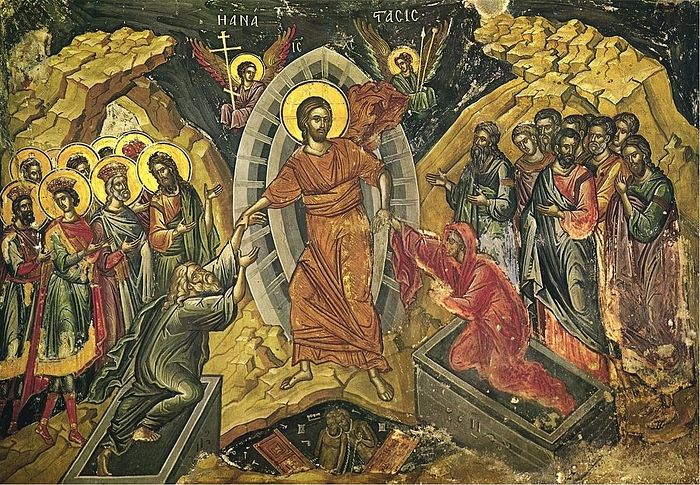 Photo: days.pravoslavie.ru
Photo: days.pravoslavie.ru There is a kind of ancient confidence—and do you know why? This is something we’re going to talk about in the introduction to the Bible. The Bible does not have to be perfect to be true. Think about that. The Bible doesn’t have to be perfect to be true. The Gospels are apostolic testimony. That’s why they’re Scripture: because the Church recognized them as inspired, as Holy Scripture, and not because they met some human standard of perfection—because that is impossible. And how the Holy Spirit shows to inspire this Evangelist to include this detail or tell the story this way and another Evangelist something else, that’s for the Holy Spirit to do. The Holy Spirit blows where it will, and it blows how it will. So these are the kinds of things we will be discussing, concepts of inspiration and inerrancy, the relationship between the human author and the Holy Spirit. Frankly, this is a mystery, brothers and sisters. We will talk about it in the introduction to the Bible, but I’ll tell you that there are things which cannot be fully understood by us. There is a co-working relationship between the Spirit and the Evangelist, and the Spirit allows the human writer to be human. I’m not going to resolve all the details; I’m not going to engage in harmonization. I personally think that is unnecessary. I allow the Gospels to present the story the way they see fit, the way they were inspired to do so, even though the Gospels have some variations. We will discuss the reason for this in the series that will begin after the series on the Resurrection. Though the Gospels have some variations, as I said, there are certain commonalities among them and we don’t see huge differences. You would have a reason to worry if there were tremendous differences: this Evangelist only talks about the women, this Evangelist only talks about the men, or this one only talks about the empty tomb. Then you’d have reason to worry. But there is actually a pretty basic consistency and commonalities among the Evangelists. What do we see? The visit to the tomb by the women early in the morning on Sunday morning, they find the tomb empty. There are at least a couple of Gospels that talk about angelic appearances to women, telling them that He is Risen. We have the disciples running to the tomb and reporting back to the eleven disciples, a separate appearance to Mary Magdalene, to the eleven with Thomas and without Thomas, etc. There’s a degree of overlapping, and so we do not have inconsistency.
Anyhow, you get my point. Every Evangelist does not tell every story—you should know this too. Even when he knows the story, he doesn’t tell it. This doesn’t mean that there’s a conflict. Now here is how you can see this. Look at the Gospel of Luke. In the story of the appearance of Christ on the road to Emmaus (I have to say I think this is my favorite Resurrection appearance), the Lord appears to two disciples. Remember when I told you there were many more than twelve disciples? Well here are two that we know about to whom He appears on the day of Resurrection. Only one is named, Cleopas, and there’s another unnamed disciple. He appears to them on the road to Emmaus, they’re walking along talking about what had happened over the weekend, the death of the Lord, the Messiah. The Lord comes alongside and asks them what they’re talking about, then He explains why the Messiah had to die. It’s a beautiful story. I love how the Lord explains the Scriptures. He opens up the Scriptures to them and explains the prophecies. I think that’s so beautiful. He pretends like He’s going to continue on the road, but night is coming so they stop for the night, and He reveals who He is to them. They don’t recognize Him; it says that they were prevented from recognizing who He was. But they recognize who He was in the breaking of the bread: They invite Him to take the bread and say the blessing over the bread. And when He breaks the bread, which has a Eucharistic connotation, they immediately recognize Him and He immediately disappears from their sight. It’s such a beautiful story, such a powerful story. So go back and read that, that’s in the Gospel of Luke, chapter 24. When this happens, they’re just amazed, and they get up immediately, even though it’s dark, it’s night, and they return to Jerusalem to tell the Eleven about what has happened. The Eleven already know about the Resurrection.
These are the same people who didn’t believe the women, as is told in the Gospel of Luke; earlier that morning they didn’t believe that the women said the Lord has risen indeed. He has appeared to Simon (Simon means Peter). So, Luke knows about an appearance to Peter alone, without others present, before he appears to the Eleven, but He’s the only Evangelist who mentions it. And He only mentions it secondarily. He only mentions it indirectly within the context of the story that occurs on the road to Emmaus—that’s the only reason we know that Luke knows about it, but Luke doesn’t tell us about it. You see what I’m saying? So just because they know about everything doesn’t mean they tell us about everything; they’re not going to write everything. What did the Gospel of John say? “If everything was written down the world could not contain all the books that would be written.” So although they know about it, they can’t include every detail, just as I can’t tell you everything I would like to tell you in this program, but that doesn’t mean I don’t know about it. Some of you write and say, “Don’t you know about this?” Yes I know about it, but I’m not going to tell you everything, because I don’t have time to tell you everything. So the Evangelists don’t tell us everything they know.
The disciples have come back and they’ve told about this appearance on the road to Emmaus, and suddenly the Lord is in the midst of them. This suggests that He appears to all of them, because this is the gathering in the upper room. This is the gathering to the Eleven. However, it does not tell us that Thomas was not present at the time—we learn about that from John.
Now, all of these things happen on the day of Resurrection, Easter Sunday. He appears to Mary Magdalene, He appears to the myrrhbearers, to Simon Peter, to the two disciples on the road to Emmaus, to the Eleven, and probably there were other appearances of the Risen Lord on that same day within a very short period of time. So many things happened within a short period of time, and no Evangelist tells us all of the stories. Each one tells us just one or two stories. It’s not fair to criticize them for that. “Why did you write your Gospel this way, why didn’t you tell us all of the stories, why weren’t you all in agreement”? When we see a beautiful painting, do we say to the artist, “Why did you paint it this way? Why didn’t you some other way?” Or, “Why did you write your song this way? Why did you start high and go low instead of starting low and going high with your song?” So, you know, we have to get over this. We have to appreciate the Gospels for what they are. These are compositions. The Evangelists were free to tell the story. Part of this has to do with the way you understand inspiration, you see. We’ll get to that later, so let’s leave this for now. I think I’ve talked about this enough, but I hope you understand what I’m trying to tell you. The veracity of the Gospels and the Bible in general does not depend on the complete harmonization of all of the details. The Bible is much bigger than that, inspiration is much broader than that, and truth is much bigger than that.


